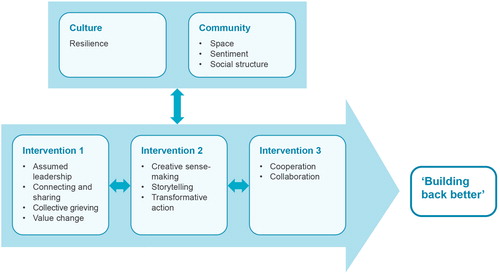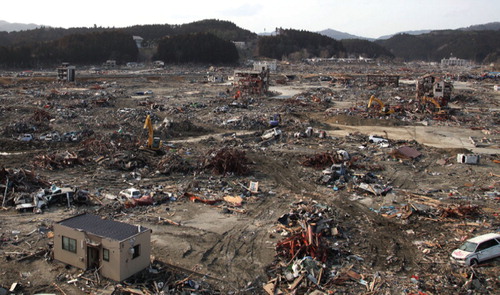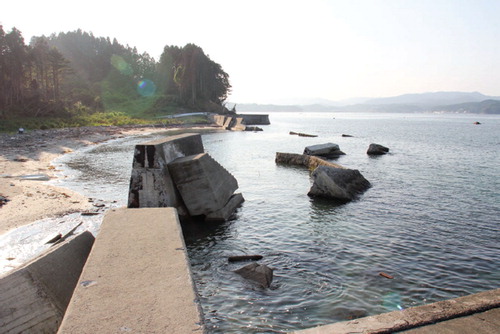COMMUNITY-BASED OPERATIONAL RESEARCH may be one of Operational Research’s least appreciated sub-disciplines. Today, with the world reeling from the COVID-19 pandemic, it might become one of the most important. Could the spectacular bottom-up revitalisation of a disaster-hit Japanese town offer lessons for the way ahead?
The largest earthquake ever to hit Japan struck on a March afternoon nine years ago. Its epicentre was 43 miles off the Tōhuku region’s Oshika Peninsula, and its hypocentre – its sub-surface point of origin – was at an underwater depth of approximately 18 miles. With a magnitude of 9.0, it qualified as a “great” quake – that is, one capable of inflicting total destruction.
So powerful that it shifted the entire island of Honshu 8ft to the east, the shock triggered a tsunami whose waves topped a dozen storeys in height. They travelled towards shore at up to 400mph before sweeping over the Japanese mainland, killing in excess of 15,000 people and leaving hundreds of thousands homeless.
Among the worst-affected areas was Minamisanriku, a small coastal town in the Miyagi prefecture. More than 800 residents died or were lost, and around 3,000 buildings were destroyed. The devastation encompassed roads, schools, hospitals and other infrastructure. The beach, for so long the heart of a 17,000-strong community heavily reliant on its fishing industry, was buried beneath a giant slew of debris.
Confronted with the prospect of post-disaster recovery on a massive scale, the Japanese government set aside US$263 billion for intensive reconstruction and revitalisation across 20 prefectures. Yet, redevelopment efforts quickly proved uneven, with some projects inevitably taking precedence over others.
Minamisanriku was not high on the list of priorities. Incidents such as the meltdown at the nearby Fukushima nuclear plant dominated the political and economic agendas, rendering official action sluggish and fragmented. In tandem, the town increasingly feared the advent of “dark tourism” – a phenomenon rooted in visitors’ fascination with the lingering effects of death and desolation. As the crisis dragged on, locals decided to take matters into their own hands.
The remarkable story that followed would redefine long-held conceptions of bottom-up regeneration. It would show how “active leadership” can turn tragedy and despair into renewal and hope. It would demonstrate the significance of networks, cultural practices and collective interventions in shaping project management. It would even give rise to what is now being hailed as a revolutionary and resolutely positive form of tourism – one rooted in resilience, sustainability, place-based practices and natural beauty. And it would shed fresh light on one of O.R.’s less appreciated sub-disciplines.
CBOR should entail “meaningful community engagement”
COMMUNITY-BASED O.R.: PUTTING THEORY INTO PRACTICE
Community-based O.R. – also known as CBOR or simply community O.R. – is thought to have its origins in the USA, where O.R. practitioners began working with communities in the late 1960s. There were similar collaborations in the UK by the mid-1970s, and the designation “community O.R.” was coined around a decade later as the OR Society sought to apply its members’ expertise to “real-life” problems beyond the public and private sectors.
Although a formal definition remains elusive, several recent additions to the literature have argued that CBOR should entail “ meaningful community engagement”. This, it has been suggested, ensures that communities themselves have a substantial say in framing issues and actions alike.
Of particular interest in the case of Minamisanriku is CBOR’s role in disaster management. Historically, much of the focus in this field has been on mitigation, preparedness and response – the first three stages of the disaster operations cycle that has been widely used for more than 30 years – with the notion of recovery relatively overlooked.
“It’s now generally recognised that community participation is an important element of disaster management,” says Professor Mihaela Kelemen, a member of the research team that analysed Minamisanriku’s renaissance. “This might involve risk perception, vulnerability assessments or building resilience, all of which are obviously useful. Yet even today the emphasis is largely on observable characteristics that can be modelled and measured, as a result of which most approaches to disaster management – even those that do encourage community participation – still tend to be primarily top-down and driven by policy.”
In Minamisanriku, by stark contrast, the approach was conspicuously bottom-up and driven by locals. “The principal motivation came from fishermen,” says Kelemen. “They reasoned that reconstruction would be a long and slow process if left to the government and that there was an urgent need to move things forward themselves.”
A fundamental corollary of this realisation was that community leaders had to become project leaders. In other words, the people of Minamisanriku would take the lead in determining their own collective future. As one fisherman remarked when interviewed by researchers: “Someone had to make a start to pull things together and get life back on track.”
LESSONS IN PROJECT MANAGEMENT
This “active leadership” first manifested itself in the identification of objectives and relevant stakeholders. The beach rapidly assumed centre stage, with the community embarking on a huge clean-up operation after local youngsters complained that they missed playing on Minamisanriku’s golden sands. “We did it to fulfil the dreams of our children,” one community leader told researchers, “because if such dreams come true then our community becomes more united and resilient in its attempts to build back.”
Thus, the overarching goal of “building back better” was born. As this idea gathered momentum via word of mouth and increasing media outreach, the clean-up campaign and related fundraising activities eventually attracted more than 3,000 volunteers – not just from elsewhere in Japan but from other countries, including the USA and the UK.
Pre-Disaster
-
Integrate cultural context and community features into any planning decisions
-
Be culturally aware of the socio-historical environment of potentially disaster-prone communities
-
Put in place training for voluntary and official services at the local level for emergency disaster procedures
-
Ensure all potentially vulnerable areas are supplied with the necessary equipment
-
Provide education programmes for volunteers and residents
-
Put in place safe physical spaces
-
Promote the value and necessity of sharing
-
Immediately Post-Disaster
-
Be aware of cultural traditions concerning the loss of loved ones, property and livelihood
-
Provide communal grieving spaces and places of communal congregation
-
Consider the cultural role of emotional, social and psychological counselling and deploy the most appropriate support mechanisms
-
Use “cultural animation”, a form of intervention that can be developed and employed by local agencies in the aftermath of disaster*
-
Promote a more cooperative model of rebuilding and new business generation
-
Planning for the Future
-
Put people at the centre of participatory reconstruction and work with communities at risk
-
Wherever possible, decentralise actions and decisions
-
Consider the interactions and mutual strengths of multi-agency networks
-
Assess the tools and resources needed for mutual cooperation
-
Establish emergency committees than can work together to put in place interventions if needed (rather than wait to react)
-
Adopt a more holistic approach that integrates the rebuilding of the general infrastructure with that of livelihoods and local markets
-
Ensure community remobilisation in the planning process and allow affected households and businesses to take collective action by developing their own plans for recovery
-
Source: Goulding, C, M. Kelemen and T. Kiyomiya (Citation2018) European Journal of Operational Research 268: 899. *More information about this approach can be found in the paper.
Subsequently, as the project expanded, stakeholder management emerged as an essential task. The tension between the community and the government, each of which had a distinct vision of Minamisanriku’s journey back to normality, was among the conflicts that demanded constant and careful attention. Communication and interpersonal skills were crucial. “Without well-meaning collaborative efforts,” said one community leader, “it’s hard to make any progress.”
Few residents had been spared some sort of human or material loss, so empathy was imperative. So, too, was the need to share in success – even if many of the “victories” were often small. Here, the “softer” skills of disaster management were very much to the fore. As one local observed: “Participation gives me a sense of achievement. It changes my mood. If I don’t do anything then I’ll worry too much about my future, my family, my children… The leaders give us hope.”
Finally, project leaders had to grasp the sociocultural context of their endeavours. Japanese culture is overwhelmingly hierarchical, authoritarian and respectful of seniority, yet Minamisanriku’s bottom-up and self-led recovery flew in the face of these traditions.
“The project’s leaders had to show considerable skills to navigate such a complex social and cultural map,” says Kelemen, a Professor of Business and Society at Nottingham University Business School. “Ultimately, these softer skills were probably even more important than the technical skills that are predominantly associated with more conventional projects. Enormous sensitivity was required, and this could actually be the key lesson from Minamisanriku in terms of the broader application of CBOR.”
A FRAMEWORK FOR THE CO-CREATION OF KNOWLEDGE
Drawing on Minamisanriku’s experience, Kelemen and her fellow researchers propose a novel framework for “building back better” in the wake of disaster. As can be seen in , this takes as its starting points the concepts of culture and community.
FIGURE 1 THE SOCIOCULTURAL DYNAMICS OF POST-DISASTER RECOVERY
Source: Goulding, C, M. Kelemen and T. Kiyomiya (2018). European Journal of Operational Research 268: 892.

“In the sphere of O.R.,” says Kelemen, “these are understandably seen as factors that are difficult to explain and even harder to quantify or measure. As Minamisanriku’s renaissance has shown, though, the fact that they’re inherently ‘fuzzy’ doesn’t mean that they don’t matter. The reality is that everything flows from them, and failure to account for them can diminish the effectiveness of any intervention – or, worse still, lead to the wrong kind of intervention altogether.”
As shown in the panel on an earlier page, such a framing need not be confined only to the recovery phase: it can also be applied in preparing for and safeguarding against disaster. None of this means that disaster can be prevented, but it should at least mean that the effects can be more easily dealt with – and that the impact of a similar disaster, should tragedy strike again, will be lessened.
Today, of course, such thinking has arguably unprecedented resonance. The far-reaching consequences of the COVID-19 pandemic and lockdown have brought crisis to communities all around the globe, and the challenges of responding at a more localised level are likely to persist for many years. With this in mind, believes Kelemen, what the story of Minamisanriku truly reveals is the enduring value of the co-creation of knowledge.
The far-reaching consequences of the COVID-19 pandemic and lockdown have brought crisis to communities all around the globe, and the challenges of responding at a more localised level are likely to persist for many years
“Minamisanriku proved that anyone can be a difference-maker, and we’re seeing that again now,” she says. “Community members, frontline workers, the people who tend to go undeservedly unnoticed when times are comparatively calm – these individuals and groups have a wealth of highly significant insights to offer, which is why their voices need to be heard. As ‘insiders’, they bring experience, on-the-ground know-how and common sense when there are decisions to be made or solutions to be devised. I think it’s fair to say that many interventions haven’t taken sufficient account of this in the past.”
According to the research team’s analysis, one of the beauties of Minamisanriku’s resurgence was that nobody claimed to have all the answers. In the parlance of academia, it was a pluralist and participatory undertaking. Today, as the world moves from shock to adaptation to whatever might pass for “new normals”, this ethos may mark the way forward. “No-one in Minamisanriku took the view that they had plenty to convey and precious little to absorb,” says Kelemen. “Everybody contributed something to the process, and everybody derived something from it as well. As O.R. practitioners, we should be very excited by such a dynamic.”
softer skills were probably even more important than the technical skills that are predominantly associated with more conventional projects. Enormous sensitivity was required, and this could actually be the key lesson from Minamisanriku in terms of the broader application of CBOR
Additional information
Notes on contributors
Neil Robinson
Neil Robinson is the managing editor of Bulletin Academic, a communications consultancy that specialises in helping academic research has the greatest economic, cultural or social impact.
FOR FURTHER READING
- Goulding, C. , M. Kelemen and T. Kiyomiya (2018). Community-based response to the Japanese tsunami: A bottom-up approach. European Journal of Operational Research 268: 887–903.
- Lin, Y. , M. Kelemen and T. Kiyomiya (2017). The role of community leadership in disaster recovery projects: Tsunami lessons from Japan. International Journal of Project Management 35b: 913–924.
- Lin, Y , M. Kelemen and R. Tresidder (2017). Post-disaster tourism: Building resilience through community-led approaches in the aftermath of the 2011 disasters in Japan. Journal of Sustainable Tourism 26b: 1766–1783.
- Midgley, G. , M. P. Johnson and G. Chichirau (2018). What is community operational research? European Journal of Operational Research 268: 771–783.
- Ufua, D.E. , T. Papadopoulos and G. Midgley (2018). Systemic lean intervention: Enhancing lean with community operational research. European Journal of Operational Research 268: 1134–1148.


